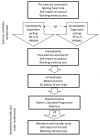Effect of a Single Bout of Acute Aerobic Exercise at Moderate-to-Vigorous Intensities on Motor Learning, Retention and Transfer
- PMID: 32013119
- PMCID: PMC7077249
- DOI: 10.3390/sports8020015
Effect of a Single Bout of Acute Aerobic Exercise at Moderate-to-Vigorous Intensities on Motor Learning, Retention and Transfer
Abstract
Acute exercise influences human cognition, and evidence suggests that learning can be improved. According to the cognitive-energetic approach towards exercise cognition, exercise represents a stressor that elevates physiological arousal, which, in turn, increases the availability of mental resources. However, the degree of arousal is hypothesized to have optimal and suboptimal states, and moderate intensity exercise is thus considered to be favorable compared to low intensity and vigorous exercise. The current evidence for such a moderating effect of exercise intensity on motor learning, however, appears somewhat mixed. Therefore, the purpose of this study was to explore the effect of aerobic exercise conducted with different exercise intensities on immediate practice, transfer, and 24-hour retention of a motor skill. To this end, young adults (n = 40, mean (SD) age: 23.80 (1.98) years) were randomized to exercise at either 50% or 75% of age-predicted maximal heart rate according to the Karvonen formulae. Immediately after exercising, participants practiced a high-precision golf putting task in a blocked design. Retention and transfer of skill were assessed after 24 h. Results indicated that both groups demonstrated motor learning, retention, and transfer at a similar level. Further works are thus needed to establish the specific relationship between exercise and learning and establish the factors that have an influence.
Keywords: arousal; endurance training; motor skill; practice.
Conflict of interest statement
The authors declare no conflict of interest
Figures




Similar articles
-
Investigating the acute effect of low and moderate intensity aerobic exercise on whole-body task learning and cognition in young adults.Eur J Neurosci. 2024 Sep;60(6):5203-5216. doi: 10.1111/ejn.16504. Epub 2024 Aug 13. Eur J Neurosci. 2024. PMID: 39136270
-
The Effect of an Acute Bout of Moderate-Intensity Aerobic Exercise on Motor Learning of a Continuous Tracking Task.PLoS One. 2016 Feb 22;11(2):e0150039. doi: 10.1371/journal.pone.0150039. eCollection 2016. PLoS One. 2016. PMID: 26901664 Free PMC article. Clinical Trial.
-
A Single Bout of Moderate Aerobic Exercise Improves Motor Skill Acquisition.PLoS One. 2015 Oct 27;10(10):e0141393. doi: 10.1371/journal.pone.0141393. eCollection 2015. PLoS One. 2015. PMID: 26506413 Free PMC article.
-
Comparison of cardioprotective benefits of vigorous versus moderate intensity aerobic exercise.Am J Cardiol. 2006 Jan 1;97(1):141-7. doi: 10.1016/j.amjcard.2005.07.130. Epub 2005 Nov 16. Am J Cardiol. 2006. PMID: 16377300 Review.
-
Does physical activity benefit motor performance and learning of upper extremity tasks in older adults? - A systematic review.Eur Rev Aging Phys Act. 2017 Sep 12;14:15. doi: 10.1186/s11556-017-0181-7. eCollection 2017. Eur Rev Aging Phys Act. 2017. PMID: 28919929 Free PMC article. Review.
Cited by
-
Test-retest reliability of putting-related variables in medium-to-high handicap golf players.Sci Rep. 2024 May 20;14(1):11516. doi: 10.1038/s41598-024-62183-z. Sci Rep. 2024. PMID: 38769123 Free PMC article.
-
Exercise alters cortico-basal ganglia network metabolic connectivity: a mesoscopic level analysis informed by anatomic parcellation defined in the mouse brain connectome.Brain Struct Funct. 2023 Nov;228(8):1865-1884. doi: 10.1007/s00429-023-02659-2. Epub 2023 Jun 12. Brain Struct Funct. 2023. PMID: 37306809 Free PMC article.
-
Aerobic exercise and aerobic fitness level do not modify motor learning.Sci Rep. 2021 Mar 8;11(1):5366. doi: 10.1038/s41598-021-84764-y. Sci Rep. 2021. PMID: 33686100 Free PMC article. Clinical Trial.
-
Effects of an Acute High Intensity Exercise Bout on Retention of Explicit, Strategic Locomotor Learning in Individuals With Chronic Stroke.Neurorehabil Neural Repair. 2023 Sep;37(9):628-639. doi: 10.1177/15459683231195039. Epub 2023 Aug 30. Neurorehabil Neural Repair. 2023. PMID: 37646138 Free PMC article.
-
Effects of Lactate on Corticospinal Excitability: A Scoping Review.Int J Exerc Sci. 2024 Dec 1;17(2):1429-1443. doi: 10.70252/QMEY1068. eCollection 2024. Int J Exerc Sci. 2024. PMID: 39807387 Free PMC article. Review.
References
LinkOut - more resources
Full Text Sources

